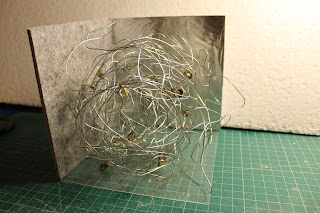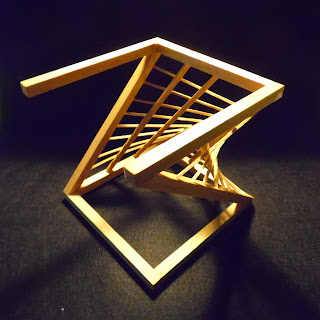One more edition of my course Architectural Toys at FAUP (faculty of Architecture of the University of Porto) is over. Also this year I had a lot of enrolled students and some very interesting works were produced, let me show you some of them.
Ana Filipa Dias work is based on the urban scale in a very simple and intuitive way: a black board (made by slat) with chalk and some wooden volumes. The child can sketch a city with streets, green areas or water and put on it some buildings in order to understand concepts like urban scale, density, street or block.
 |
| Ana Filipa Dias - The Poster |
 |
| Ana Filipa Dias - The prototype |
Bruna Nunes focused on a specific element: the small shelter Le cabanon by Le Corbusier. It was built between 1951-1952 is where Le Corbusier preferred to spend summers in the months of August and September. The small building was designed based on the "Modulor" a system of measures directly related to the human scale, invented by Le Corbusier. The child can learn about measures, proportions and space playing with this model, a kind of doll house, that is openable in different ways in order to allow interact with it.
 |
| Bruna Nunes - The poster |
The toy designed by Catarina Brites is based on a tridimensional optic effect. Indeed with plan surfaces child can create several different volumes, even buildings. It is very simple and cheap, can made by a printed sheet of paper, but with a strong visual effect. One of the most interesting aspect is that the child can make several mistakes and through them create new and unsuspected shapes. So the mistake can really be part of the creative process.
 |
| Catarina Brites - The poster |
 |
| Catarina Brites - The prototype |
Guilherme Oliveira designed a toy for space creation. It is based on a wooden board where the child can insert different walls and create interior and exterior space in a simple way. Changing the wall material, like transparent or not unique materials, the child can experience different spaces and relations.
 |
| Guilherme Oliveira - The prototype |
Indira Nunes fell in love with the Charles and Ray Eames toy "THE TOY" and decided to create a new version. The result was quite interesting manly because she understood the real complexity of that toy and of the producing technologies involved.
 |
| Indira Nunes - The poster |
 |
| Indira Nunes - The prototype |
Joana Bicas worked on a stamps system. Based on Le Corbusier work she developed a kit with a book and stamps that the child can use in the proper way. So behind an aesthetic value based on a specific figure of the architecture, the use of this toy develops scale comprehension and perspective understanding. Also in this toy the mistake can be a learning source because it can provides new and unexpected solutions.
 |
| Joana Bicas - The Poster |
 |
| Joana Bicas - The prototype |
Jolan Haidinger designed a wooden construction set with vivid colors and a specific shape. It is always a very stuff challenge because it is quite difficult to find a shape that should be at the same time simple and complex enough to allow the creation of several tridimensional figures.
 |
| Jolan Haidinger - The poster |
Julien Ponsar made a structure that can be used in several ways and position in order to create different spaces where the child can move, interact or simply stay. The structure, made by steel or aluminum, can be combined with tissue or other materials and can be easily mounted in a garden or in a public space.
 |
Julien Ponsar - The Poster
|
 |
Julien Ponsar - The model
|
Also the work of Lise Kerdraon is for exterior use. Based on flexible sticks that are threaded in a tissue to create a tent that can assume several different configurations for different uses. The tissue can be elastic and tensioned between the sticks and has a very interesting shape determinated by the moutend elements.
 |
| Lise Kerdraon - the poster |
 |
| Lise Kerdraon - The prototype |
Robert Somod explored a technology based on wooden blocks and elastics connections to create a toy that can change it's own shape and create several figures. The technology was adapted to architecture to create an arc or other building elements, but can also be used for animals or other objects.
 |
| Robert Somod - The prototype |
 |
| Robert Somod - The prototype |
Finally (because the alphabetic order) I post the work of Sara Vila Cova. It is a construction set that use the small straws that come with the beverages. With a simple connection system the child can build wire-frame structures. Sara also developed a packaging idea for promote her toy that is quite simple: just put in each pack a small plastic bag with some connection and a short description.
 |
| Sara Vila Cova - The prototype |




























































